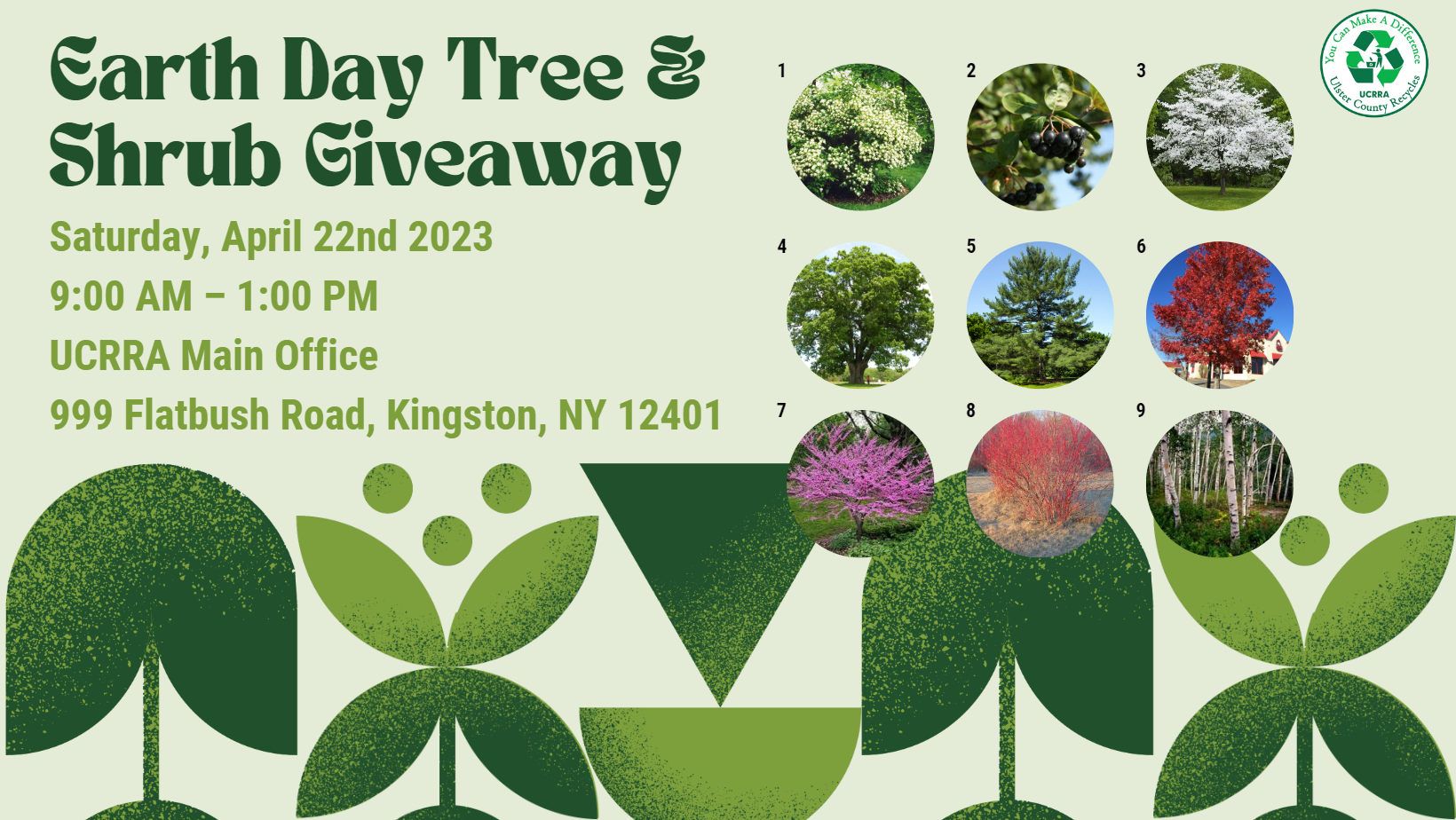

Earth Day at UCRRA
April 22, 2023 @ 9:00 am - 1:00 pm

On Saturday, April 22nd, residents that drop off electronics for recycling and/or residents that pick up an order of bagged compost will receive a free tree sapling/shrub as our gift to you to celebrate Earth Day! Please note: tree saplings/shrubs will be distributed while supplies last, with limited inventory available, and several different options to choose from!
This program is made possible by the Ulster County Soil & Water Conservation District. The organization has shared excess inventory from their Annual Sale. While we cannot guarantee which tree/shrub species will be available; the giveaway may include the following species:
Arrowwood Viburnum (1), Black Chokeberry* (2), White Flowering Dogwood* (3), White Oak (4), White Pine(5), Red Maple (6), Eastern Redbud* (7), Red Osher (8), Paper Birch (9)
*Indicates pollinator-friendly species. All species are native varieties. Saplings may range in size from 6 inches to 2 feet.
Accessibility: This is an outdoor event. There will be a station for the tree distribution where residents may park in designated parking area to walk over to an outreach booth for more information and for trees. We can also accommodate curbside service. We encourage all visitors to practice social distancing.
Instructions for Planting Trees & Shrubs
Source: United States Composting Council (USCC) Consumer Compost Use Program
Establishment: Excavate a planting hole slightly shallower and 2 to 3 times the width of the root ball or container. Set the root ball on firm soil so that the top of the root ball sits slightly higher than the final grade. Uniformly blend compost with the excavated soil at one (1) part by volume compost to 2-3 parts by volume soil. Compost with higher amounts of salts and nutrients should be used at lower rates (e.g. 1:3 or 1:4 parts compost to soil). Backfill and firm the soil blend around the root ball within the planting hole. Always water thoroughly after planting. It should be noted that whenever possible, trees and shrubs should be planted in a mass planting bed, where multiple plants are established in a larger amended bed. This technique allows for greater planting success. Lower compost application rates should be used for salt sensitive crops (e.g., conifers), or where composts possessing higher salt and nutrient levels are used, while higher application rates may be used for plants that require greater amounts of fertility.
Maintenance: Apply a coarser compost mulch (1” – 2” screened) over the garden bed to conserve moisture, for weed suppression
and/or for aesthetic purposes. Note: The nutrients contained in compost should be considered when applying fertilization. They
will typically offset plant nutrient requirements, thereby potentially reducing fertilizer application rates.
Compost has many horticultural benefits and uses.
- Compost adds a slow release of nutrients
- Compost adds beneficial soil organisms, reducing the need to use chemical pesticides
- Compost aids in suppressing plant disease pathogens, reducing the need to use chemical fertilizers
- Compost increases moisture retention, so you don’t need to add water to garden beds as frequently
- Compost helps improve soil structure, porosity, and density
- Compost makes any soil easier to work and cultivate
Disclaimer: The USCC makes no warranties regarding UCRRA’s Compost product or its contents, quality, or suitability for any particular use. Please refer to the individual producer’s product label for specific use instructions.
Learn more by viewing the UCRRA Rack Card Tree & Shrub
Learn more about the Agency’s Certified Compost by viewing the UCRRA Brochure STA Program

We’re Celebrating Earth Day!
The first Earth Day was celebrated in 1970, when a U.S. Senator organized a national demonstration about environmental issues and environmental conservation. By the end of the year, the Environmental Protection Agency was created. And by 1990, Earth Day was celebrated internationally by 140 countries.
According to National Geographic, roughly 15 billion trees are cut down each year around the globe. Trees absorb carbon dioxide and release oxygen, essential for life on Earth! Trees also provide shelter and food for wildlife and help cool the climate. By taking part in activities like planting trees, and using compost, we can all do our part to create a healthier, more sustainable planet.
Recycled Paper Facts:
By weight, more paper is recovered for recycling in America than all other materials combined (except for steel). In 1988, recovered paper made up about 25 percent of the raw materials used at US paper mills. That figure rose to 36.3 percent in 1999 and has remained around 36-37 percent through 2007. More than 3/4 of America’s paper mills use recovered fiber to make some or all of their products. Approximately 140 mills use recovered paper exclusively. As a result, virtually all types of paper products contain some recycled fiber. Since 1994, significantly more paper has been recovered in America than landfilled. Source: Environmental Protection Agency.
